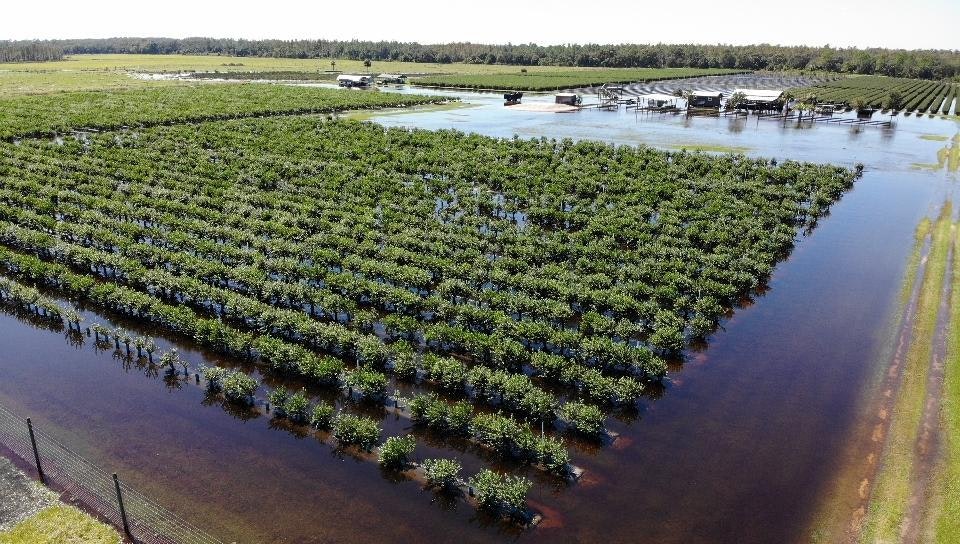Weathering the Storm
Hurricane Season Planning Tips From the Pros
We are now officially in another hurricane season, and it’s a good time to think about how to prepare your farm for a possible major storm. Florida has been impacted by nine hurricanes since 2000. As of this article’s writing, Hurricane Ian was the most recent major storm to affect the state (September 2022). It made landfall in southwest Florida as a Category 4 storm with maximum sustained wind speeds of 150 mph and accumulated rainfall of up to 20 inches, with estimated losses of more than $1 billion.
The three major causes of plant damage from hurricanes are wind damage, flooding, and disease.
Wind Damage
Hurricane-force winds are sustained winds of at least 74 mph (Category 1 storm), and can increase to more than 156 mph with a Category 5 storm. Hurricane-force winds, as well as tropical storm-force winds (between 39 and 73 mph), can cause significant physical damage to blueberry plants, including defoliation (Figure 1) and uprooting.
Untimely defoliation can have a negative impact on blueberry production the following spring. Most blueberry flower bud initiation in Florida occurs in late summer and throughout the fall. A full complement of healthy leaves is needed at that time for optimal flower bud initiation and subsequent flower bud development. Early fall defoliation can potentially reduce flower bud numbers as well as reduce the number of florets (and potential berries) per flower bud. The impact of defoliation and other wind damage to remaining leaves could be even more critical for blueberry plants grown in an evergreen system, where healthy foliage is needed throughout the fall, winter, and early spring.
.png?ixlib=rb-1.1.0&w=2000&h=2000&fit=max&or=0&s=43b4fd52e65583cc42461a0f8be25d35)
Figure 1. Blueberry plant foliage damage from hurricane force winds
Credits: D. Phillips, UF/IFAS
Blueberry plants are typically shallow-rooted and hurricane-force winds can damage plants by uprooting them, resulting in the need to reset and stake these plants. Exposed root systems of uprooted plants can be damaged quickly under hot, sunny, conditions. Also, breakage of woody stems and the root system can significantly impair transport of water and nutrients throughout the plant, and wounds also provide entry points for several stem and root pathogens including Botryosphaeriastem blight, sometimes months after the wind damage and plant stresses occur.
Flooding
Flooding from a hurricane or tropical storm can create multiple problems for blueberries because there can be standing water in the fields for several days following a significant storm (Figure 2). Blueberry plants generally do not tolerate saturated soil conditions well.

Figure 1. Blueberry farm flooding from Hurricane Ian
Credits: D. Chapman
Flooding can result in root death due to greatly reduced oxygen levels in the root zone under saturated soil conditions (hypoxia). Flooding injury can negatively impact plant health by reducing root and shoot growth, leaf number and expansion, and nutrient uptake. Leaf abscission, reduced flower bud number, smaller flower buds and fruit, and reduced yield may occur. The effects of flooding on plant health may not be readily apparent for a number of months following the storm. Minimizing the length of time that flooded conditions persist by pumping water from the field may help to limit the damage. One disease that thrives in flooded conditions is Phytophthora root rot.
Disease
The three factors that must be present for plant disease are an active pathogen, favorable environmental conditions for disease development, and a susceptible host. Each of these factors can be affected by a hurricane.
Pathogen—high winds, wind-driven rain, and rising surface water can spread pathogens into and throughout a production field to areas where they may not have been present previously.
Environment—flooded soils and extended rainfall associated with major storms, along with the hot and humid conditions common in Florida during summer and early fall, are ideal conditions for successful pathogen infections into blueberry plants. As mentioned previously, Phytophthora root rot is an example of a blueberry pathogen that thrives under high soil moisture conditions and warm soil temperatures.
Plant Host—blueberry plants that suffer the types of storm damage discussed above are considerably stressed and weakened. Such plants are more susceptible to pathogen infection and disease development when compared to healthy plants.
The following are suggestions for storm preparation and post-storm management taken from Impacts of Hurricane Damage on Southern Highbush Blueberries, UF/EDIS https://edis.ifas.ufl.edu/publication/HS1342.

Before the Storm—Farm Preparations
- Check fields for surface water drainage. Ensure that ditches, canals, areas between beds, and the ends of rows are clear and that water can flow freely out of production fields.
- Make sure to have sufficient diesel fuel on hand to operate farm equipment and drainage pumps.
- Check that generators and chainsaws are working properly.
- Scout for potential debris and secure items that may be propelled by strong winds before the storm.
- Purchase materials for resetting plants blown over during the storm (e.g., bamboo stakes and tie tape).
- Purchase mefenoxam containing products (e.g., Ridomil, Ultra Flourish, Orondis, etc.) and phosphorous acid products (“phytes”) to manage Phytophthora root rot in case of prolonged flooded conditions.
- Secure important records and documents, including production records, financial records, and insurance documents.
The Florida Division of Emergency Management has additional hurricane preparation information at https://www.floridadisaster.org/planprepare/preparing-for-hurricane-season/.

After the Storm—Management Suggestions
One should consistently apply the following best management practices after a hurricane to alleviate or avoid additional plant stress:
- Reset and stake uprooted lodged plants as quickly as possible to reduce losses from desiccation and plant death.
- Examine irrigation systems when waters recede to make sure they are functioning properly.
- Repair raised beds and weed cloth, and resume bed irrigation and pH monitoring, adjusting as necessary.
- Carefully monitor irrigation after the storm and rains pass to prevent further drought stress in plants with damaged root systems.
- Resume scheduled fertilizer applications after waters have receded and when beds begin to drain. Consider reducing the rates of nitrogen where plants have been stressed, and begin to slowly return to recommended timings and rates for the given deciduous or evergreen production system.
- Look for disease symptoms and insect pests. Apply management and control suggestions as appropriate; see EDIS Publication HS1156, “2022 Florida Blueberry Integrated Pest Management Guide” (https://edis.ifas.ufl.edu/publication/HS380).

Ideally, applications of Ridomil or another mefenoxam fungicide that help prevent Phytophthora root rot will have already been made in early summer prior to hurricane activity. Two applications of these products per year are allowed, and where a second application was not made earlier, consider making that application prior to a predicted storm impact when possible. When not possible, the second application can be made after waters have receded either in a banded bed application or through certain irrigation systems. (Consult the product label for more details.) These applications can help prevent root rot development, but they will not cure severely affected plants or those dying from flooding (hypoxia). Also consider making foliar applications of phosphorous acid products (“phytes”) when field conditions allow.
- Good record keeping is important to document any losses suffered. Include detailed production records from prior years and pictures and video of all areas of the farm affected by the storm.
For additional information see EDIS Publication HS1342, Impacts of Hurricane Damage on Southern Highbush Blueberries (https://edis.ifas.ufl.edu/publication/HS1342).

Link to Orginal Article fro Florida Blueberry Growers Association
CREDITS:
DOUG PHILLIPS, Blueberry Extension Coordinator, Horticultural Sciences Department, UF/IFAS
& DR. JEFFREY WILLIAMSON, Professor, Horticultural Sciences Department, UF/IFAS
